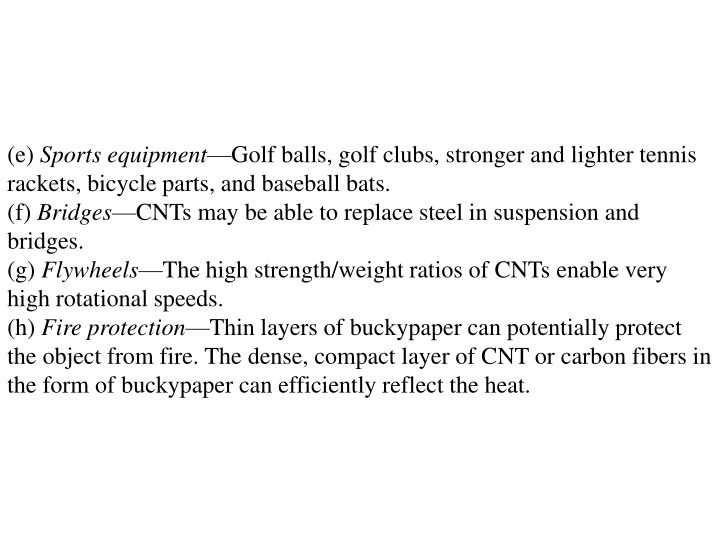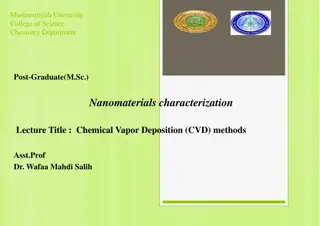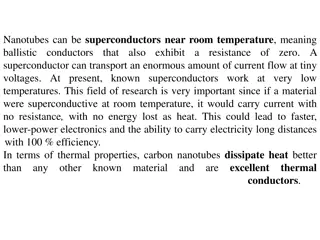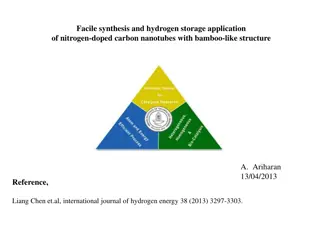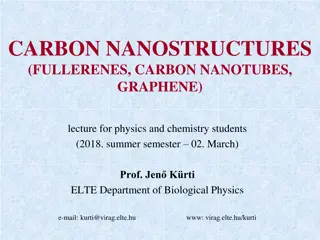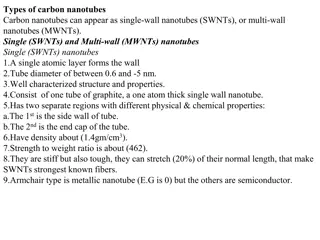Applications of Carbon Nanotubes in Various Industries
Carbon nanotubes (CNTs) have revolutionized multiple industries with their unique properties. They are utilized in sports equipment, bridges, flywheels, fire protection, electromagnetic devices, chemical applications, water filtration, nanowire manufacturing, and sensors. CNTs enhance the performance of golf balls, tennis rackets, bridges, magnets, air and water filters, sensors for temperature detection, and more. Their versatility and strength make them invaluable in modern technology.
Uploaded on Mar 12, 2025 | 0 Views
Download Presentation

Please find below an Image/Link to download the presentation.
The content on the website is provided AS IS for your information and personal use only. It may not be sold, licensed, or shared on other websites without obtaining consent from the author.If you encounter any issues during the download, it is possible that the publisher has removed the file from their server.
You are allowed to download the files provided on this website for personal or commercial use, subject to the condition that they are used lawfully. All files are the property of their respective owners.
The content on the website is provided AS IS for your information and personal use only. It may not be sold, licensed, or shared on other websites without obtaining consent from the author.
E N D
Presentation Transcript
(e) Sports equipmentGolf balls, golf clubs, stronger and lighter tennis rackets, bicycle parts, and baseball bats. (f) Bridges CNTs may be able to replace steel in suspension and bridges. (g) Flywheels The high strength/weight ratios of CNTs enable very high rotational speeds. (h) Fire protection Thin layers of buckypaper can potentially protect the object from fire. The dense, compact layer of CNT or carbon fibers in the form of buckypaper can efficiently reflect the heat.
2. Electromagnetic CNTs can be fabricated as electrical conductors, semiconductors and insulators. Such applications include: (a) Light bulb filament CNTs can be used as alternative to tungsten filaments in incandescent lamps. (b) Magnets A strong magnetic field can be generated using multi- walled CNTs coated with magnetite. (c) Solar cells Germanium CNT diode exploits the photovoltaic effect. In some solar cells, nanotubes are used to replace the ITO (indium tin- oxide) to allow the light to pass to the active layers and generate photocurrent. (d) Electromagnetic antenna CNTs can act as an antenna for radio and other electromagnetic devices due to its durability, light weight and conductive properties .
3. Chemical CNTs finds tremendous applications in the chemical field also, few of them are as follows: (a) Air pollution filter CNTs are one of the best materials for air filters because they possess high adsorption capacity and large specific area. The conductance of CNTs changes when polluted gas comes in its contact. This helps in detecting and filtering the polluted air . CNT membranes can successfully filter carbon dioxide from power plant emissions .
(b) Water filterCNT membranes can aid in filtration. It can reduce distillation costs by 75 %. These tubes are so thin that small particles (like water molecules) can pass through them, while blocking larger particles (such as the chloride ions in salt). CNTs have high active site and controlled distribution of pore size on their surface. This increases not only its sorption capabilities, but also its sorption efficiency. CNTs have effective sorption capacity over broad pH range (particularly for 7 to 10 pH).
(c) Chemical NanowiresThe CNTs finds their applications in nanowire manufacturing using materials such as gold, zinc oxide, gallium arsenide, etc. The gold based CNT nanowires are very selective and sensitive to hydrogen sulphide (H2S) detection. The zinc oxide (ZnO) based CNT nanowires can be used in applications for light emitting devices and harvesters of vibrational energy.
(d) SensorsCNT based sensors can detect temperature, air pressure, chemical gases (such as carbon monoxide, ammonia), molecular pressure, strain, etc. The operation of a CNT based sensor is primarily dependent on the generation of current/voltage. The electric current is generated by the flow of free charged carrier induced in any material. This charge is typically modulated by the adsorption of a target on the CNT surface. A CNT based fabricated gas sensing device is shown in Fig. 3.
4. Mechanical The potential application of CNTs can be found in the following areas of mechanical engineering as well : (a) Oscillator Oscillators based on CNTs have achieved higher speeds than other technologies (>50 GHz). Researchers reported a molecular oscillator with frequencies upto several gigahertz. The operation of this oscillator is primarily based on the low friction and low wear bearing properties of a multi-walled CNT with a diameter ranging from 1 nm to a few tens of nanometers.
(b) WaterproofCNTs can be used to prepare superhydrophobic cotton fabric by dip-coating approach. This approach is solely based on the chemical reactions caused by UV-activated nitrene solution. The solution is used to transform the cotton fabric surface from hydrophilic to superhydrophobic with an apparent water contact angle of 154 . Since CNTs are covalently attached on the surface of the cotton fabric, the superhydrophobicity possesses high stability and chemical durability.
5. Optical Carbon nanotubes are grown like a field of grass, where each nanotube is separated like a blade of grass. Thus, a particle of light bounces between the nanotubes. In this process, light is completely absorbed and it is converted to heat. Therefore, the absorbance of CNT is extremely high in wide ranges from FUV to FIR [FUV (Far Ultraviolet): 100-200 nm; FIR (Far Infrared): 50- 1000 m].
6. Electrical Circuits CNTs are attractive materials in fundamental science and technology. They have demonstrated unique electrical properties for building electronic devices, such as CNT field-effect transistors (CNTFETs) and CNT diodes. CNTs can be used to form a p n junction diode by chemical doping and polymer coating. These types of diodes can be used to form a computer chip. CNT diodes can potentially dissipate heat out of the computer chips due to their unique thermal transmission properties.
